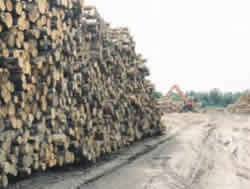The most wide-reaching provincial economic forecast of the year, the Ontario Economic Update 2016, was released today by the Ontario Chamber of Commerce and the Credit Unions of Ontario, with support from the North Bay & District Chamber of Commerce.
According to the data, issued in a news release, Northeastern Ontario’s economic prospects are set to improve based in part on the strength of gains in the forestry sector.
"The analysis finds that after a difficult year where employment contracted in Northeast Ontario, some commodity markets are beginning to find their footing. In particular, Ontario’s forest sector is experiencing gains, with overall forest products shipments climbing 12 percent in the first nine months of 2015, compared to the same period last year. A strengthening U.S. economy, a weak Canadian dollar, and a rebound in housing markets bodes well for forest products, particularly lumber."
However, any contribution from primary production will not kick in until 2017. In the interim, job growth will be very modest, with employment set to grow at a 0.4 yearly rate in 2016 and 2017.
The industries contributing most to near-term economic growth are retail-wholesale trade, health-social services, and other services.
Also acting as an economic driver is the development and conversion of the Energy East Pipeline, which cuts across the Northeast Economic Region, and will support more than $700 million in construction activity through to its expected completion in 2018.
While the region experienced strong housing sales in 2015 (7.8 percent residential sales growth), this activity belies underlying weakness in Sudbury, Sault Ste. Marie, Timmins and North Bay, where average sales prices have slipped year-to-date.
According to the province-wide data, most areas of Ontario will enjoy improving economic conditions in the coming year. Growth will be driven in part by an uptick in exports, the result of a stronger U.S. economy and a low Canadian dollar. Government fiscal policy will also be a key driver, as federal and provincial infrastructure commitments will stimulate growth across a variety of sectors.
Allan O’Dette, President & CEO of Ontario Chamber of Commerce: “Ontario businesses are helping Ontario emerge stronger from the downturn. However, our economy still faces significant challenges. In order to generate sustained economic growth, government must invest in infrastructure, close the skills gap, and ensure that input costs do not stifle investment or job creation.”
Helmut Pastrick, Chief Economist, Central 1 Credit Union: “Ontario and its regional economies will grow at a moderate but faster pace through 2017 aided by favourable external factors such as the low dollar and interest rates and an improving U.S. economy. Most regions will participate and contribute to Ontario’s improved economic prospects though differences exist among regions. Resource-based regions will be weighed down by poor metal markets.”
Key Facts and Highlights:
● The Northeast Economic Region covers Greater Sudbury and the counties of Nipissing, Parry Sound, Manitoulin, Sudbury, Timiskaming, Cochrane and Algoma and is home to over 560,000 residents.
●After jumping to a projected 7.9 percent in 2015, little improvement is forecast in the unemployment rate over the forecast period as population outflows are offset by a modest rise in the labour force participation rate. The regional unemployment rate will fall to 7.5 percent by 2017.
●Average residential housing prices slipped in 2015, to $212,500, a decline of 1.7 percent.
Download the full economic outlook at: http://www.occ.ca/advocacy/ontario-economic-update-2016/



